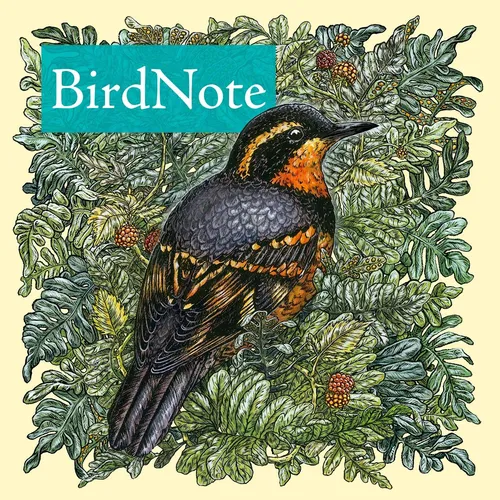
BirdNote Daily
Escape the daily grind and immerse yourself in the natural world. Rich in imagery, sound, and information, BirdNote inspires you to notice the world around you.
- Update frequency
- every day
- Average duration
- 1 minutes
- Episodes
- 1171
- Years Active
- 2022 - 2025

Kenon Walker, Duckmaster
Kenon Walker got one of the most unusual job offers you can get: be the Duckmaster of the Peabody Hotel in Memphis. That means he would lead the hotel’s five ducks on a daily march to the fountain in…

Small Birds Mob Big Ones
When smaller birds join forces to ward off larger birds, it's called mobbing. This behavior — like calling your family for help — is used by many bird species. The best time to observe mobbing is spr…

Winter Birds Love Suet
Birds at a suet feeder... What a burst of vitality on a chilly morning! What's the attraction? A cake of suet, suspended from a branch in a small wire feeder. Suet is beef fat, a high-energy food cri…

Alpine Swifts Fly Nonstop
How long can a bird fly without touching the earth? To find out, Swiss scientists attached sensors to Alpine Swifts. The sensors showed long periods when the swifts were gliding and not flapping thei…

The Harpy Eagle Is a Huge, Powerful Hunter
Harpy Eagles spend their lives in tall, remote tropical forests in Central and South America, flying from tree to tree in search of food. The eagles are named for the Harpies of Greek mythology, wome…

The Verdin’s Winter Roosts
For small songbirds, surviving a cold winter night can be challenging. Their bodies lose heat faster than those of larger birds. So little birds have found resourceful ways to stay warm — like huddli…

Kentucky Warbler
Kentucky Warblers nest in forested regions in much of the East, preferring woodlands with a dense understory, often near streams or other wetlands. These birds can use our help. As their forest habit…

Spark Bird: Christian Cooper’s Red-Winged Blackbird
Christian Cooper wasn’t always interested in birds. His parents were teachers, his dad a science teacher, so nature was always part of his life. When he was a kid, his parents made him take a woodsho…

Dowitchers Get a Second Wind
The two American species of dowitchers, Long-billed and Short-billed, are similar in appearance but have distinctive calls. And they’re some of the continent’s most dramatic songsters. On their north…

Following the Honeyguide
The Greater Honeyguide's demanding call is not aimed at a member of its own species. Instead, the bird guides people in search of honey through the forest, directly to bee hives. The bird flies to a …

Rhea Nesting Is Mind-boggling
A typical bird nest will have maybe four to six eggs neatly arranged by the parent to hunker down on. But in one Rhea nest, you may find between 50 and 80 eggs! And they’re not all from the same set …

Moonwalking Manakins
The Golden-headed Manakin is a tiny bird with dance moves that would turn a pop star green with envy. Johanne Ryan, a nature educator who lives in Trinidad, describes this bird’s remarkable breeding …

Listening From Inside the Egg
Shorebird chicks hatch into a dangerous world, so they need to be vigilant from the start. Researchers in Australia noticed that some shorebird chicks began chirping in their final days in the egg. T…

Spark Bird: Corina Newsome Meets the Blue Jay
In an ornithology class in college, Corina Newsome was introduced to the Blue Jay. After this, Newsome was determined to learn about the world of birds she had never noticed before.
More info and tran…

Pigeons Can Correct Their Mistakes Like AI
Birds have to be smart to survive — but their minds often work a little differently than ours do. In a new study, researchers trained pigeons to identify different types of shapes, peck a button to g…

The Beauty of Webbed Feet
Webbed feet are ideal for birds that swim, on the water’s surface or under. In fact, they’re such a nifty adaptation that they evolved, independently, in several bird groups. Ducks and geese, gulls, …

Powder Down
Hidden below the outer breast feathers of herons, pigeons, doves, tinamous, bustards and some parrots are patches of special down feathers. These feathers are never molted, and they grow continuously…

Storm-Petrels: Myth and Reality
Sailors once believed Wilson’s Storm-Petrels foretold a dangerous tempest. There might be a grain of truth: the tiny seabirds might find a little shelter from the gusts near a ship. Wilson’s Storm-Pe…

The Haunting Voice of the Common Loon
The call of the Common Loon brings to mind a summer visit to northern lakes. A "yodel" call is given by a male on his breeding territory. With his neck outstretched, the male waves his head from side…

Why Do Grebes Eat Their Feathers?
Eared Grebes eat brine shrimp and aquatic insects for sustenance, but rigid exoskeletons make them hard to digest. So these grebes – along with their other grebe cousins – evolved to use their feathe…